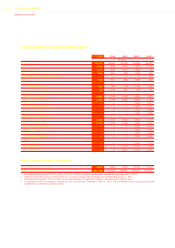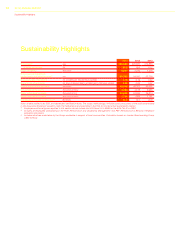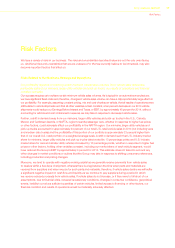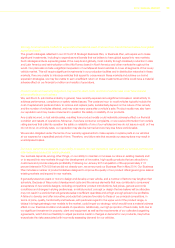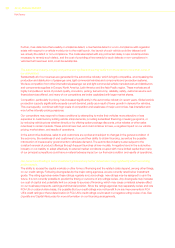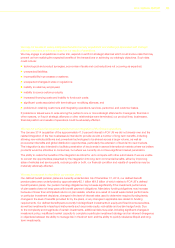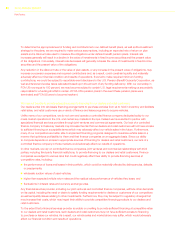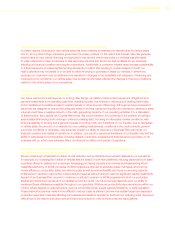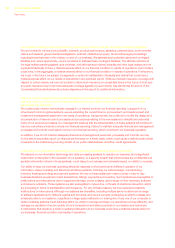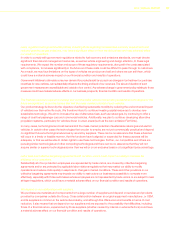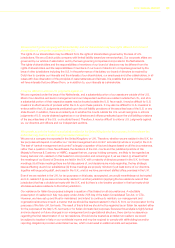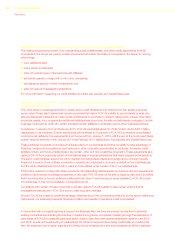Chrysler 2014 Annual Report Download - page 24
Download and view the complete annual report
Please find page 24 of the 2014 Chrysler annual report below. You can navigate through the pages in the report by either clicking on the pages listed below, or by using the keyword search tool below to find specific information within the annual report.
22 2014 | ANNUAL REPORT
Risk Factors
To determine the appropriate level of funding and contributions to our defined benefit plans, as well as the investment
strategy for the plans, we are required to make various assumptions, including an expected rate of return on plan
assets and a discount rate used to measure the obligations under defined benefit pension plans. Interest rate
increases generally will result in a decline in the value of investments in fixed income securities and the present value
of the obligations. Conversely, interest rate decreases will generally increase the value of investments in fixed income
securities and the present value of the obligations.
Any reduction in the discount rate or the value of plan assets, or any increase in the present value of obligations, may
increase our pension expenses and required contributions and, as a result, could constrain liquidity and materially
adversely affect our financial condition and results of operations. If we fail to make required minimum funding
contributions, we could be subject to reportable event disclosure to the U.S. Pension Benefit Guaranty Corporation, as
well as interest and excise taxes calculated based upon the amount of any funding deficiency. With our ownership in
FCA US now equal to 100 percent, we may become subject to certain U.S. legal requirements making us secondarily
responsible for a funding shortfall in certain of FCA US’s pension plans in the event these pension plans were
terminated and FCA US were to become insolvent.
We may not be able to provide adequate access to financing for our dealers and retail customers.
Our dealers enter into wholesale financing arrangements to purchase vehicles from us to hold in inventory and facilitate
retail sales, and retail customers use a variety of finance and lease programs to acquire vehicles.
Unlike many of our competitors, we do not own and operate a controlled finance company dedicated solely to our
mass-market operations in the U.S. and certain key markets in Europe. Instead we have elected to partner with
specialized financial services providers through joint ventures and commercial agreements. Our lack of a controlled
finance company in these key markets may increase the risk that our dealers and retail customers will not have access
to sufficient financing on acceptable terms which may adversely affect our vehicle sales in the future. Furthermore,
many of our competitors are better able to implement financing programs designed to maximize vehicle sales in a
manner that optimizes profitability for them and their finance companies on an aggregate basis. Since our ability
to compete depends on access to appropriate sources of financing for dealers and retail customers, our lack of a
controlled finance company in those markets could adversely affect our results of operations.
In other markets, we rely on controlled finance companies, joint ventures and commercial relationships with third
parties, including third party financial institutions, to provide financing to our dealers and retail customers. Finance
companies are subject to various risks that could negatively affect their ability to provide financing services at
competitive rates, including:
the performance of loans and leases in their portfolio, which could be materially affected by delinquencies, defaults
or prepayments;
wholesale auction values of used vehicles;
higher than expected vehicle return rates and the residual value performance of vehicles they lease; and
fluctuations in interest rates and currency exchange rates.
Any financial services provider, including our joint ventures and controlled finance companies, will face other demands
on its capital, including the need or desire to satisfy funding requirements for dealers or customers of our competitors
as well as liquidity issues relating to other investments. Furthermore, they may be subject to regulatory changes that
may increase their costs, which may impair their ability to provide competitive financing products to our dealers and
retail customers.
To the extent that a financial services provider is unable or unwilling to provide sufficient financing at competitive rates
to our dealers and retail customers, such dealers and retail customers may not have sufficient access to financing
to purchase or lease our vehicles. As a result, our vehicle sales and market share may suffer, which would adversely
affect our financial condition and results of operations.


